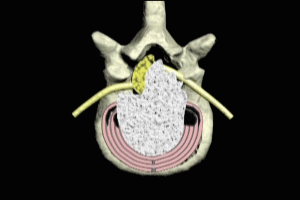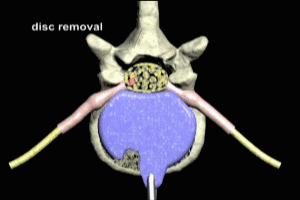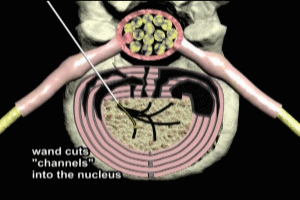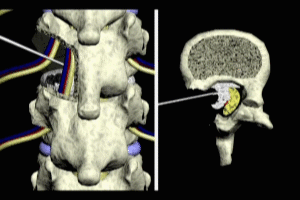Lumbar Disc Herniation Transcript
Lumbar Disc Herniation
This is Dr. Cal Shipley with a review of disc herniation in the spine.
Herniation of intervertebral discs with symptomatic involvement of nerve structures accounts for thousands of cases of disability in the United States annually. The discs situated between the fourth and fifth lumbar or L4-L5 vertebra, and the fifth lumbar and first sacral or L5-S1 vertebra are the most commonly affected by disc herniation.
L4-5 and L5-S1 Discs
The intervertebral discs are made of a firm but flexible material that act as shock absorbers between the spinal vertebrae. Situated as they are at the bottom of the spine, the L4-L5 and S1 vertebra, and their accompanying discs, bear considerable stress as a result of the weight and movement of the upper body. Additional stress on these joints arises by virtue of the fact that they allow for most of the movement of the lower back, with the L4-L5 joint allowing for most of the rotational movement, while the L5-S1 permits the majority of flexion and extension of the lower spine.
Spinal Nerve Roots
Nerve roots originating from the spinal cord exit between the vertebrae at each level on the left and right side. To clarify the anatomical relationships, let’s rotate the fifth lumbar vertebra and look at it from above.
The spinal cord ends at the level of the second lumbar vertebra, giving off multiple branches which become the nerve roots to the remaining lumbar and sacral vertebral segments. These lower nerve roots when bundled together in the spinal canal are known as the cauda equina. The left and right spinal nerve roots branch off of the cauda equina. The intervertebral disc sits on top of the vertebra, and therefore between the L4 and L5 vertebrae.
Lumbar Disc Structure
An examination of the inner structure of the disc makes it easier to see how age-related degeneration or trauma may result in herniation of the disc. Seen in cross-section, the disc is composed of two primary structures, the annulus, a tough fibrous outer shell, and the nucleus, the softer inner core. The annulus gives the disc its strength, while the nucleus provides flexibility and cushioning.
Lumbar Disc Herniation
Either as a result of age-related degenerative change or trauma, tears may occur in the annulus. These tears weaken the annulus resulting in a loss of its structural integrity and leading to bulging of the disc as a result of the pressure exerted from the spine above. Weakening of the annulus fibrosis may ultimately result in through and through tears of its fibers with extrusion of the nucleus pulposus outside the confines of the annulus as seen here. This is known as a disc herniation.
This example shows a pretty extreme herniation with severe compression of the cauda equina. Ultimately, the extruded nuclear material may harden and calcify into a solid mass. Depending on the severity and direction of the disc herniation, the spinal nerve roots or the nerves of the cauda equina may be compressed, as in this example, resulting in numbness, pain or weakness in the tissues and muscles supplied by the compressed nerves.
For information on the treatment of disc bulges and herniation, please see my reviews of lumbar discectomy and fusion, treatment of bulging disc and costotransversectomy.
Cal Shipley, M.D. copyright 2020




